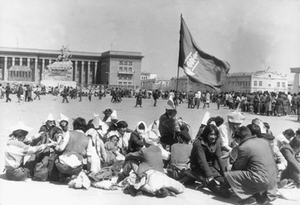
Back الثورة المنغولية 1990 Arabic Монголска революция (1990) Bulgarian Revolució democràtica de Mongòlia Catalan Mongolische Revolution von 1990 German Revolución democrática de Mongolia Spanish Mongolian vallankumous 1990 Finnish Révolution démocratique de 1990 en Mongolie French Revolusi Mongolia 1990 ID Rivoluzione democratica della Mongolia nel 1990 Italian モンゴル民主化運動 Japanese
This article's tone or style may not reflect the encyclopedic tone used on Wikipedia. (April 2021) |
| Mongolian Revolution of 1990 | |||
|---|---|---|---|
| Part of the Revolutions of 1989 | |||
 Hunger strikers near the Government Palace in Ulaanbaatar, 1990 | |||
| Date | 10 December 1989 – 9 March 1990 (2 months, 3 weeks and 6 days) | ||
| Location | |||
| Resulted in | Mongolia transitions to a multi-party system
| ||
| Parties | |||
| Lead figures | |||
| History of Mongolia |
|---|
 |
The Mongolian Revolution of 1990, known in Mongolia as the 1990 Democratic Revolution (Mongolian: 1990 оны ардчилсан хувьсгал, romanized: 1990 ony ardchilsan khuvisgal), was a peaceful democratic revolution which led to the country's transition to a multi-party system. It was inspired by the economic reforms of the Soviet Union in the late 1980s and was one of the many revolutions of 1989. It was led mostly by young demonstrators who rallied at Sükhbaatar Square, in the capital city Ulaanbaatar. The main organisers of the demonstrations included Sanjaasürengiin Zorig, Erdeniin Bat-Üül, Davaadorjiin Ganbold, Tsakhiagiin Elbegdorj, Bat-Erdeniin Batbayar.
Although one-party rule in Mongolia officially ended with the adoption of a new constitution on 12 February 1992, the Mongolian People's Revolutionary Party (MPRP) remained in power until it was outvoted by the Democratic Union Coalition in the 1996 legislative election. However, the country had already begun transitioning to a market economy by 1991 with the creation of the stock market and the Government Privatization Committee.[1]
- ^ Bilskie, Julia S.; Arnold, Hugh M. (January 1990). "An Examination of the Political and Economic Transition of Mongolia Since the Collapse of the Soviet Union". Journal of Third World Studies. 19 (2): 205–218. JSTOR 45194063.